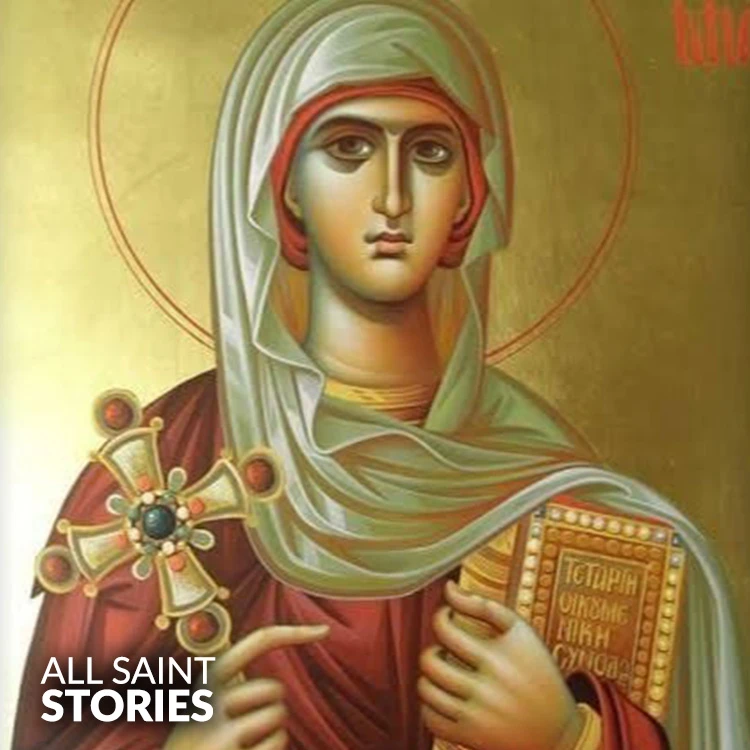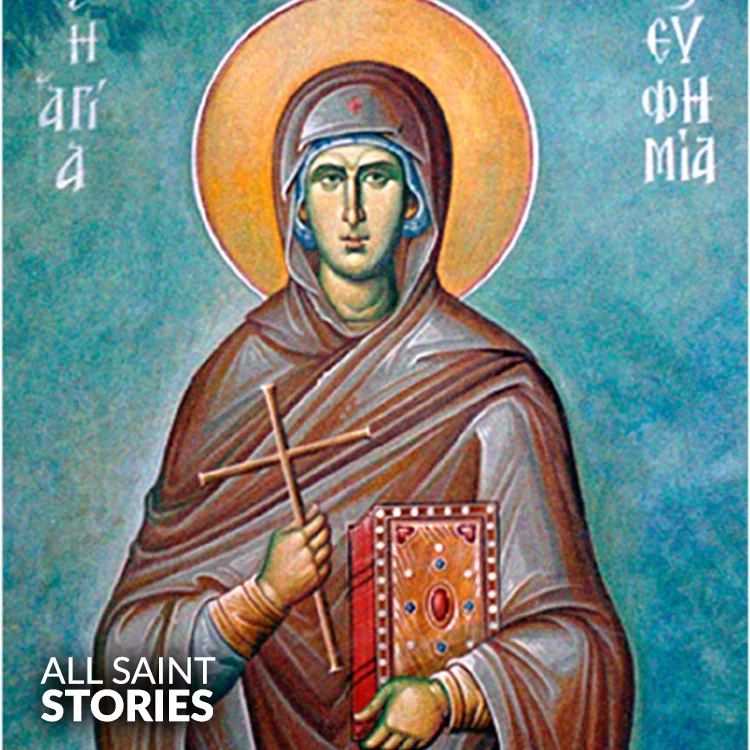O glorious virgin and martyr, St. Euphemia, through your steadfast faith and courage, you glorified Christ in suffering. Intercede for us before His throne, that we may remain unwavering in truth and love, and attain the crown of eternal life. Amen.
ST. EUPHEMIA
ST. EUPHEMIA

St. Euphemia was a young virgin martyr of the early 4th century, martyred under Emperor Diocletian. Known for her courage during persecution, she is honored especially for her miraculous role at the Council of Chalcedon in 451 AD. Her feast day is celebrated on September 16.
St. Euphemia was a Christian virgin martyr who lived in Chalcedon, a city in Bithynia (modern-day Turkey), during the time of Emperor Diocletian’s severe persecution of Christians in the early 4th century. She is traditionally believed to have been born around 290 AD into a noble and devout Christian family. From a young age, she was dedicated to her faith and known for her piety, purity, and acts of charity.
During Diocletian’s persecution, the governor of Chalcedon issued an edict requiring all citizens to offer sacrifices to the pagan gods. Euphemia, along with 49 other Christians, refused to comply with the imperial orders. They were arrested and tortured in an attempt to force them to renounce their faith. Despite the brutal methods employed, including scourging and confinement, Euphemia and her companions remained resolute in their allegiance to Christ.
Euphemia, in particular, was singled out for further punishment due to her youthful beauty and prominent social status. Historical accounts and Church tradition recount that she was subjected to a wide array of tortures, including the rack and burning coals, and was eventually thrown to wild beasts in the arena. A miraculous aspect of her martyrdom is said to have occurred when the animals, rather than attacking her, displayed unnatural gentleness. Eventually, a bear was induced to fatally maul her, bringing about her death around the year 303 AD. She died a martyr, steadfast and joyful in her love for Christ.
Her relics became objects of great veneration, and a church was built over her tomb in Chalcedon. During the 5th century, her name and legacy took on even greater significance at the Council of Chalcedon in 451 AD, which addressed Christological controversies. The council was divided on how to understand the divine and human natures of Christ. According to Church tradition, after much debate, the conflicting confessions of faith were placed inside the tomb of St. Euphemia. When the tomb was opened three days later, the correct Orthodox definition (asserting that Christ is in two natures, fully God and fully man) was found in her right hand, and the heretical one at her feet — a miracle attributed to the saint, affirming the truth of the Chalcedonian position.
Because of this event, St. Euphemia became strongly associated with the defense of doctrinal truth in Christian theology. Her intercession is particularly invoked in matters of Church unity and truth.
Her relics were transferred multiple times due to invasions and political instability. They were taken to Constantinople and housed in a church dedicated to her in the Hippodrome. Although the relics were lost for a time, they were rediscovered and are now said to rest in the Church of St. George in Istanbul, maintained by the Ecumenical Patriarchate.
St. Euphemia's courage, martyrdom, and posthumous role in a defining moment of Christian doctrinal history make her a revered figure in both the Roman Catholic and Eastern Orthodox Churches. She is depicted in iconography holding a cross and accompanied by a lion or bear, symbolizing the mode of her martyrdom. Her feast day is celebrated on September 16, and in the Eastern tradition, an additional commemoration occurs on July 11 to mark her role at the Council of Chalcedon.
Her memory endures as a symbol of feminine strength, theological fidelity, and Christian martyrdom, inspiring generations of faithful around the world.
Video Not Found
The information on this website is compiled from various trusted sources. While we aim for accuracy, some details may be incomplete or contain discrepancies.
If you notice any errors or have additional information about this saint, please use the form on the left to share your suggestions. Your input helps us improve and maintain reliable content for everyone.
All submissions are reviewed carefully, and your personal details will remain confidential. Thank you for contributing to the accuracy and value of this resource.
Credits & Acknowledgments
- Anudina Visudhar (Malayalam) – Life of Saints for Everyday
by Msgr. Thomas Moothedan, M.A., D.D. - Saint Companions for Each Day
by A. J. M. Mausolfe & J. K. Mausolfe - US Catholic (Faith in Real Life) – Informational articles
- Wikipedia – General reference content and images
- Anastpaul.com – Saint images and reflections
- Pravachaka Sabdam (Malayalam) – Saint-related content and insights
We sincerely thank these authors and platforms for their valuable contributions. If we have unintentionally missed any attribution, please notify us, and we will make the correction promptly.
If you have any suggestion about ST. EUPHEMIA
Your suggestion will help improve the information about this saint. Your details will not be disclosed anywhere.
© 2025 Copyright @ www.allsaintstories.com


 English
English
 Italian
Italian
 French
French
 Spanish
Spanish
 Malayalam
Malayalam
 Russian
Russian
 Korean
Korean
 Sinhala
Sinhala
 Japanese
Japanese
 Arabic
Arabic
 Portuguese
Portuguese
 Bantu
Bantu
 Greek
Greek
 German
German
 Dutch
Dutch
 Filipino
Filipino